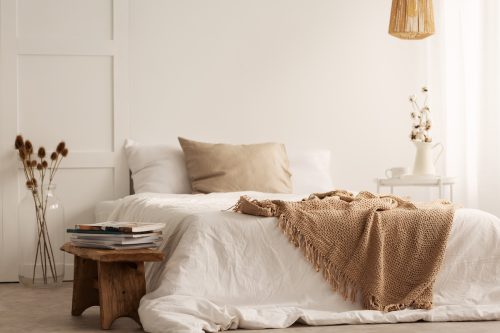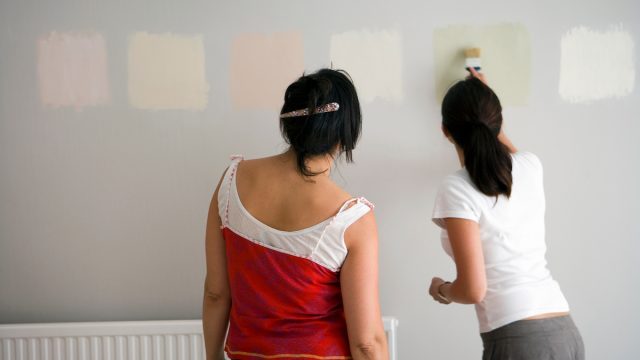The Best Colors to Paint Your Bedroom, According to Sleep Experts
All it might take for a good night's sleep is a can of paint.
When we want to improve our bedroom to get the best night's sleep, we may consider upgrading our mattress or blocking out noise and light. One thing we may not be thinking about is our walls, but according to sleep experts, the color you paint your bedroom can have a big impact.
"You want your bedroom to be a place that evokes relaxation, as this could ultimately help you sleep better," says Jill Zwarensteyn, certified sleep science coach and the editor at Sleep Advisor. "This includes the color you paint it since colors can affect our mood in different ways."
To learn which hues will have you sleeping soundly, read on to learn which colors Zwarensteyn and other sleep experts say are the best to paint your bedroom.
READ THIS NEXT: 5 House Plants That Will Help You Sleep, Experts Say.
The Best Colors to Paint Your Bedroom
Blues

Carleara Weiss, PhD, MS, RN, sleep science advisor for Aeroflow Healthcare, notes that while sleep science technically says the best colors for a bedroom are those that you personally respond to, color therapy does say certain hues are more relaxing than others. And of all colors, perhaps none is more associated with tranquility than blue.
According to Nicole Eichelberger, a BSM-certified sleep expert, there have been several studies that show blue has a calming effect on the body, "which can help to lower blood pressure, heart rate, and reduce anxiety levels."
Weiss says that pastels in general are considered relaxing colors for bedroom walls, but if you prefer a deeper blue, like a blue-gray for example, Eichelberger explains that certain darker colors "can absorb light and create a more relaxing atmosphere."
Sage Green

Speaking of pastels, light green is another hue widely recommended by sleep experts.
"Green is a soothing and calming color that can create a sense of balance and harmony," says Eichelberger. "It is also associated with nature and the outdoors, which can help to promote feelings of calm and relaxation."
Carlie Gasia, a sleep expert and certified sleep science coach at Sleepopolis, recommends a muted shade like sage green.
READ THIS NEXT: 7 Clothing Items You Should Never Sleep In, Experts Say.
Lavender

Lavender—both the color and the scent—is known to promote relaxation.
Christina Heiser, content director for bedding company Saatva, explains that "shorter wavelength" colors (cool colors) tend to feel more relaxing, and violet has the shortest wavelength on the color wheel.
"This is one of our absolute favorites for the bedroom and is as sophisticated, feminine, and romantic as it is calming," adds Philippa Radon, color and design expert at C2 Paint.
Neutrals

If the goal is calm and relaxed, neutral shades are ideal.
"Beige, tan, and cream are warm, light, and neutral, making them ideal color options for bedroom walls," says Gasia. "They represent serenity and simplicity, and beige is plain and quiet, making it a great complement to sage green in the bedroom."
Gasia also recommends white walls, as this color "is a symbol of serenity and can bring you comfort and hope."
For more sleep advice sent directly to your inbox, sign up for our daily newsletter.
Colors to Avoid

There are also plenty of colors that sleep experts recommend not painting your bedroom.
"I would avoid bright and vibrant colors like red and orange because they can bring out more energy and excitement, which isn't as conducive to sleep," says Zwarensteyn.
You may also want to steer clear of very dark colors. "Black is considered an unlucky color in many cultures, and it promotes feelings of sadness, anger, and fear," says Gasia. She adds that dark browns "make a space feel dull and dreary, rather than calm and relaxed."
Of course, personal preference will come into play. We like what we like and different colors will have different emotional impacts on various people.
"The color of a bedroom is a personal choice, and what works for one person may not work for another," explains Eichelberger. "Some people find bright, bold colors relaxing, while others prefer soft, muted tones."






















